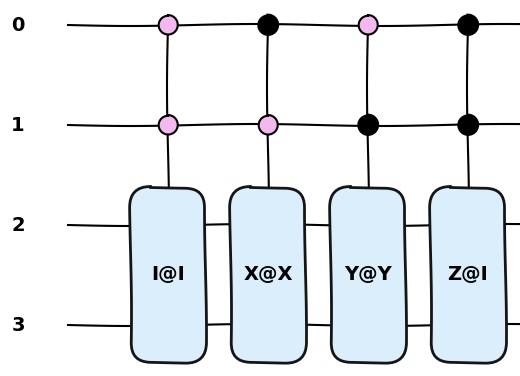qiskit_circ_make
概要
この関数は与えられた情報からQiskitで実行可能なBlock-Encodingを実行する回路を自動的に組み上げる
引数一覧
argument name |
type |
role |
|---|---|---|
gate_inf |
str |
パウリ行列積の情報 |
zero_one |
list(elements:int) |
制御ビットの状態に関する情報 |
circ |
QuantumCircuit(qulacs) |
組み上げ先の回路 |
qubit |
int |
量子回路に必要な総ビット数 |
ancilla |
int |
量子回路に必要な補助ビット数 |
Python code
def qiskit_circ_make(gate_inf, zero_one, circ, qubit, ancilla):
"""
This function automatically constructs a quantum circuit for Qiskit that performs block encoding based on the given information.
Parameters:
gate_inf: the information of Pauli matrix product
zero_one: the information of control qubits
circ: a pre-defined quantum circuit used for actual computation
qubit: the number of qubits which express the quantum state
ancilla: the number of ancilla qubits for Block-Encoding
Returns:
None.
A quantum circuit implementing Pauli operators with control qubits is created on circ.
"""
# Local Values
work_ope_order = [] # A list to store information about Pauli matrix product
input_switch = 0 # A switch to initiate reading information about Pauli matrix product
input_ele = "" # A temporary list to store information about Pauli matrix product
# If Pauli matrix product is Identity,
if gate_inf == "":
gate_a = [[1., 0.],
[0., 1.]]
unitary_gate = Operator(np.array(gate_a)).to_instruction()
for i in range(int(qubit - ancilla)):
circ.append(unitary_gate, [i])
# If Pauli matrix product is the product of some Pauli matirces (ex: X0Y2Z4Y5)
else:
# Read the Pauli operators that make up the Pauli matrix product
for i in range(len(gate_inf)):
# Determine whether to interpret each item as a coefficient, a Pauli matrix product, or to ignore it.
# 0: Read, 1: ignore
if i < len(gate_inf) - 1.5:
if input_switch > 0.3:
work_ope_order.append(input_ele)
input_ele = ""
input_switch = 0
if gate_inf[i+1] == "X":
input_switch = 1
if gate_inf[i+1] == "Y":
input_switch = 1
if gate_inf[i+1] == "Z":
input_switch = 1
if gate_inf[i+1] == "I":
input_switch = 1
input_ele += gate_inf[i]
else:
work_ope_order.append(input_ele)
input_switch = 0
work_ope_order[-1] += gate_inf[-1]
# Construct a quantum circuit from the reading results
for i in range(len(work_ope_order)):
num_inf = ""
for j in range(len(work_ope_order[i])-1):
num_inf += work_ope_order[i][j+1]
tag_num = int(num_inf)
gate_pos = qubit - tag_num - 1
gate_pos = ancilla + tag_num
cont_list = []
for j in range(ancilla):
cont_list.append(j)
cont_list.append(gate_pos)
if work_ope_order[i][0] == "X":
add_gate = XGate().control(ancilla, ctrl_state=zero_one)
circ.append(add_gate, cont_list)
elif work_ope_order[i][0] == "Y":
add_gate = YGate().control(ancilla, ctrl_state=zero_one)
circ.append(add_gate, cont_list)
elif work_ope_order[i][0] == "Z":
add_gate = ZGate().control(ancilla, ctrl_state=zero_one)
circ.append(add_gate, cont_list)
elif work_ope_order[i][0] == "I":
add_gate = IGate().control(ancilla, ctrl_state=zero_one)
circ.append(add_gate, cont_list)
実行例
[1]:
import numpy as np
import pitbe
import qiskit
#from qiskit import QuantumCircuit
from qiskit.circuit.library import ZGate, XGate, YGate, IGate
[2]:
circuit = qiskit.QuantumCircuit(4)
ope_lst = ["I0I1", "X0X1", "Y0Y1", "Z0I1"]
cont_list = ["00", "01", "10", "11"]
for j in range(len(cont_list)):
pitbe.qiskit_circ_make(ope_lst[j], cont_list[j], circuit, 4, 2)
作成された回路図

注意点
この関数は「Qiskit」向けであるため、 必ず関数のimport部分で「qiskit」をimportすること
関数circ_makeとは用いる量子計算機シミュレータが異なるため間違えないように注意すること